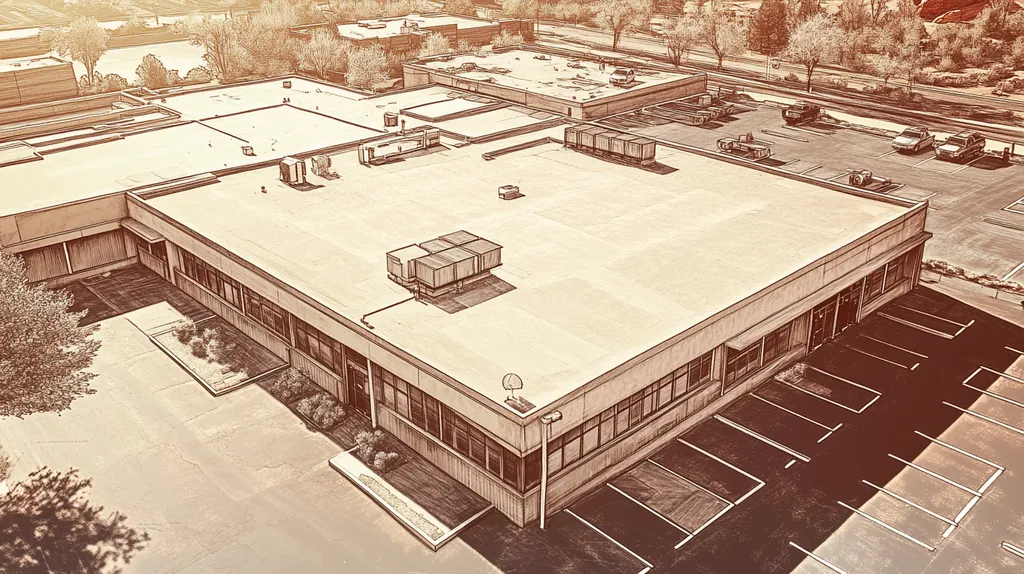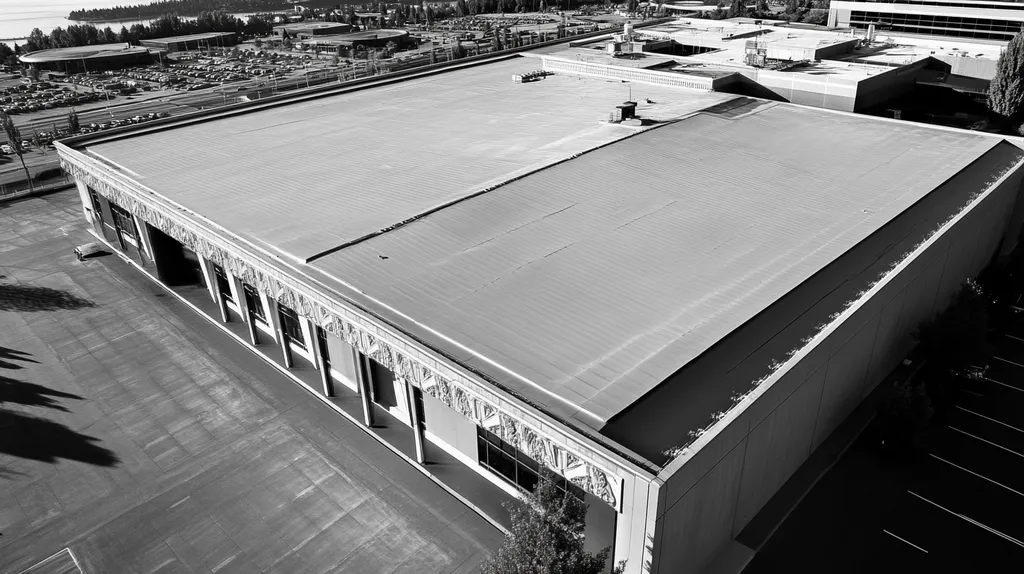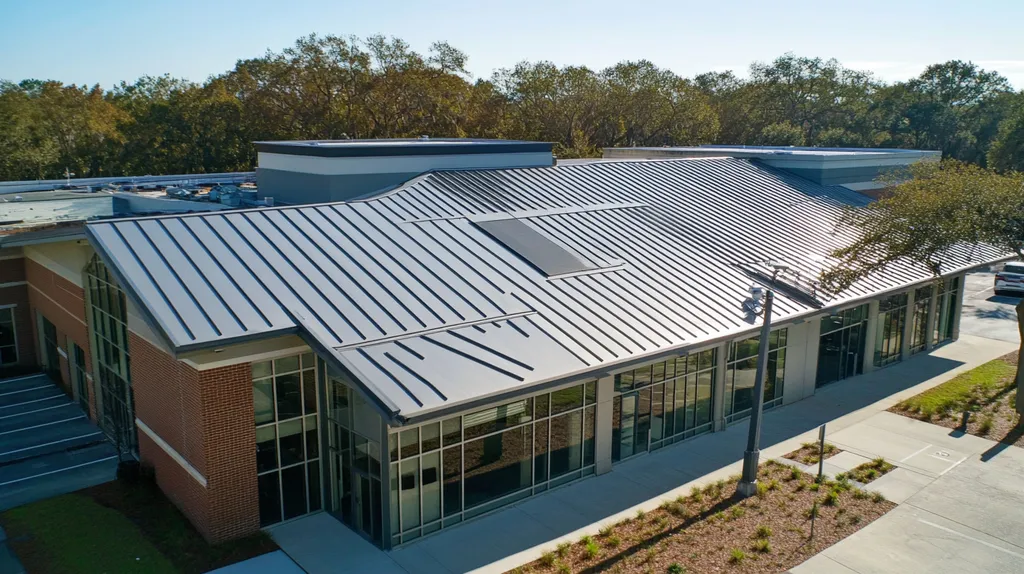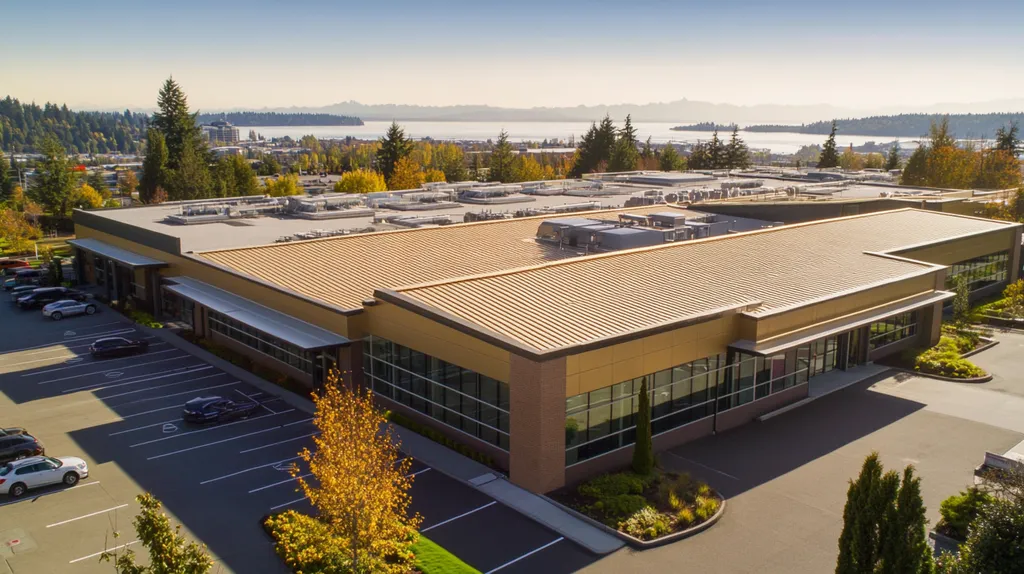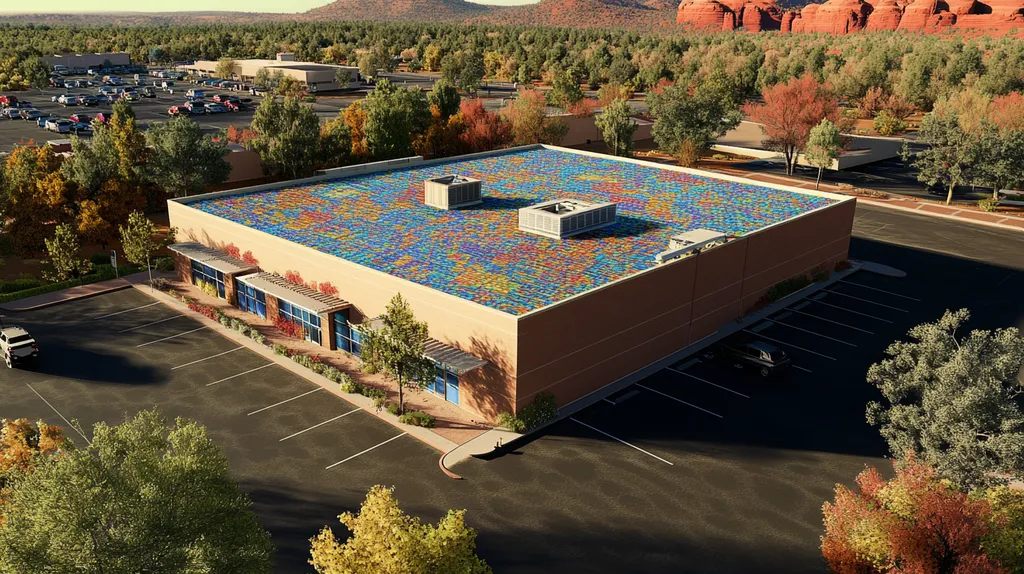Commercial roofing represents the ultimate energy efficiency paradox: the building component with the greatest thermal impact receives the least strategic attention from facility managers.
While dark conventional roofs can reach temperatures exceeding 150°F and increase cooling costs by thousands annually, reflective systems slash energy consumption by up to 20% while extending roof lifespan decades.
The difference between thermal liability and energy asset often comes down to understanding reflectivity fundamentals, avoiding common specification pitfalls, and recognizing when reflective solutions deliver maximum return on investment.
SECTION 1: THE BASICS EXPLAINED
While facility managers obsess over HVAC efficiency ratings and lighting upgrades, many overlook the building’s largest energy influencer: the roof itself. A conventional dark roof can reach temperatures of 150°F on a sunny afternoon, turning your building into an expensive solar oven.
Meanwhile, reflective roofing can slash cooling costs by up to 20% while extending roof lifespan. It’s the difference between wrestling with heat all day and making the sun work for you instead of against you.
What It Is (In Plain Language)
Reflectivity, or solar reflectance, measures how much sunlight a roof bounces back versus absorbs. Think of it as the roof’s ability to play hot potato with the sun’s energy instead of holding onto it like a heat hoarder.
When sunlight hits any surface, it faces a binary choice: reflect or absorb. Dark roofs are terrible bouncers—they let almost all the solar energy through the door.
Light-colored, reflective roofs are the opposite. They’re selective about which energy they allow to stick around.
Reflectivity gets measured on a scale from 0 to 1. A rating of 0.7 means the roof reflects 70% of incoming sunlight while absorbing only 30%.
The higher the number, the cooler your building stays. It’s that straightforward, though the engineering behind achieving high reflectivity can be quite sophisticated.
Why It Matters (To Your Building)
A cooler roof surface means dramatically less heat transfer into your building. This translates directly to reduced air conditioning demand and lower utility bills—sometimes by thousands of dollars annually.
The environmental benefits extend beyond your property line too. Reflective roofs help combat urban heat islands, those sweltering microclimates that make cities measurably hotter than surrounding areas.
There’s also a longevity bonus that accountants love. Cooler roofs experience less thermal stress, which means fewer expansion-contraction cycles that crack and deteriorate roofing materials.
A reflective roof could stay more than 50°F cooler than conventional roofing, saving energy and money in buildings with air conditioning while extending roof service life. (source: U.S. Department of Energy)
In regulatory environments increasingly focused on sustainability, reflective roofing helps meet green building requirements. It’s energy efficiency that’s literally visible from space.
How It Works
Sunlight arrives carrying energy across three main spectrums: visible light, ultraviolet, and infrared radiation. Reflective roofing systems are engineered to bounce back energy across all these wavelengths, not just the visible portion.
The magic happens through specialized pigments and surface treatments. These materials are designed to reflect not only visible light—which our eyes can see—but also the infrared radiation that carries much of the heat.
Some roofing materials combine high reflectance with high thermal emittance. Emittance is the surface’s ability to shed absorbed heat as infrared radiation back to the sky.
This one-two punch—reflecting incoming energy and radiating away any absorbed heat—creates the most effective cool roof systems. It’s like having both a good defense and a strong offense against solar heat gain.
The result is a roof that stays closer to ambient air temperature rather than becoming a massive heat source above your occupied spaces.
SECTION 2: PRACTICAL APPLICATIONS
While building owners debate LED upgrades and HVAC tune-ups, the most straightforward energy win sits right above their heads, soaking up summer sun like a thermal sponge. Reflective roofing isn’t theoretical—it’s delivering measurable savings across thousands of commercial properties right now.
The challenge isn’t whether reflectivity works, but knowing when and how to deploy it for maximum impact. Smart applications can turn your roof from an energy liability into a profit center.
Common Uses & Examples
Big box retailers lead the reflective roof revolution, and for good reason. A typical 100,000-square-foot warehouse sporting a white TPO membrane can slash cooling costs by $8,000 to $15,000 annually compared to conventional dark roofing.
Distribution centers have become early adopters too, especially those storing temperature-sensitive goods. Reflective EPDM or PVC systems keep interior temperatures stable while protecting inventory from heat damage—a double win that makes CFOs smile.
Schools and municipal buildings embrace reflective coatings as budget-friendly retrofits. A simple white elastomeric coating applied over existing roofing can boost reflectivity from 15% to 85% for a fraction of replacement costs.
Healthcare facilities increasingly specify reflective modified bitumen systems during roof replacements. Hospitals can’t afford HVAC failures, making thermal load reduction a critical reliability strategy.
Even manufacturing plants with high internal heat loads benefit from reflective roofs, which prevent solar gain from compounding their existing cooling challenges. Every BTU rejected at the roof level is one less BTU the chillers must handle.
When You Need It Most
Geography determines reflectivity’s payback speed more than any other factor. Phoenix warehouses see returns within two years, while Minneapolis facilities might wait five years for the same savings percentage.
Buildings with extensive roof area relative to their footprint—think single-story retail or industrial facilities—capture the most dramatic benefits. More roof exposure means more solar rejection opportunity.
The sweet spot hits during peak summer months when conventional roofs become 150°F heat sources. Commercial white roofs can save up to $0.20 per square foot annually in energy costs, with the greatest savings occurring in warm and hot climates. (source: Lawrence Berkeley National Laboratory)
Aging dark roofs nearing replacement create perfect timing for reflective upgrades. Why endure another summer of thermal punishment when the roof replacement was already budgeted?
Buildings pursuing LEED certification or utility rebates often discover reflective roofing provides the easiest points toward their sustainability goals. It’s visible environmental responsibility that actually pays dividends.
Interactions With Other Systems
Reflective roofing works like a well-orchestrated symphony—every building system plays better when the thermal load conductor keeps things cool. Proper insulation beneath reflective membranes prevents the few absorbed BTUs from migrating indoors.
HVAC systems experience less thermal stress when reflective roofs reduce peak cooling demands. Compressors run shorter cycles, fans work less aggressively, and equipment lasts longer when not constantly battling rooftop heat gain.
Smart building controls become more effective with reflective roofing providing consistent baseline temperatures. Energy management systems can fine-tune operations when they’re not compensating for massive solar heat spikes.
Roof-mounted equipment—from HVAC units to solar panels—operates more efficiently on cooler surfaces. Air conditioning condensers work harder on hot roof decks, while solar panels actually lose efficiency as temperatures climb.
Even building envelope details benefit from thermal stability. Fewer expansion-contraction cycles mean less stress on flashing, penetrations, and membrane seams—translating to lower maintenance costs over time.
SECTION 3: KEY TERMINOLOGY DECODED
Reflective roofing discussions turn into expensive miscommunication faster than dark asphalt heats up in July. When facility managers confuse “albedo” with “solar reflectance,” or assume all white roofs perform equally, they’re setting budgets up for thermal shock.
The industry loves its technical vocabulary, but misinterpreting key terms leads to specification errors that cost thousands in lost energy savings. Smart property owners decode the jargon before signing contracts.
Essential Terms Explained
Solar reflectance measures how much sunlight bounces off your roof instead of cooking your building. It’s scored from 0 to 1, where 0.85 means 85% of solar energy gets the cold shoulder while only 15% crashes the cooling party.
Thermal emittance describes how quickly your roof ditches absorbed heat back to the atmosphere. Think of it as your roof’s ability to exhale the thermal energy it couldn’t avoid inhaling during peak sun hours.
These two properties work as a tag team—reflectance blocks incoming heat while emittance releases whatever sneaks through. A roof with high solar reflectance can reflect sunlight and reduce the amount of heat absorbed by the building, which can help lower cooling costs. (source: Parsons Roofing)
“Albedo” technically refers to natural surfaces like snow or soil, though roofing marketers borrow the term liberally. When specifying commercial systems, stick with “solar reflectance” for precision that procurement departments appreciate.
Industry Jargon Translated
“Cool roofing” doesn’t mean fashionable—it means engineered to stay cooler than traditional dark membranes. These systems combine high reflectance with high emittance, creating the thermal equivalent of a well-ventilated white shirt versus a black wool sweater.
Solar Reflectance Index (SRI) rolls reflectance and emittance into one convenient score from 0 to 100. Higher numbers indicate superior heat rejection, making SRI the roof’s report card for thermal performance.
When contractors mention “ENERGY STAR qualified” or “LEED compliant,” they’re referencing minimum reflectance thresholds that unlock utility rebates and green building credits. These aren’t just badges—they represent measurable performance standards.
“Initial” versus “aged” reflectance reveals how materials perform after weather exposure. That pristine white membrane might lose 20% of its reflectance over three years, so smart specs account for real-world degradation.
Measurement & Units Simplified
Laboratories test solar reflectance using standardized methods like ASTM E903, which sounds technical but simply means “we shine calibrated light at samples and measure what bounces back.” Consistent testing enables apples-to-apples comparisons between manufacturers.
Reflectance gets reported as decimals (0.75) or percentages (75%), both meaning three-quarters of solar energy reflects away. Emittance follows the same scale, with most commercial roofing materials achieving 0.80 or higher.
Temperature measurements during testing use both Fahrenheit and Celsius, but the key metric is temperature differential. A reflective roof staying 40°F cooler than conventional roofing translates directly to reduced cooling loads.
Field measurements after installation verify that laboratory performance translates to real rooftops. Portable reflectometers let facility managers confirm their investment delivers promised thermal benefits, not just marketing promises.
SECTION 4: DECISION FACTORS
Reflective roofing decisions separate thermal winners from energy bill losers, yet most facility managers approach these choices like shopping for paint instead of investing in infrastructure. The difference between a well-specified cool roof and a budget compromise can mean $20,000 annually in a medium-sized facility.
Smart buyers decode the real costs, performance nuances, and durability realities before contractors start climbing ladders. These decision points determine whether your roof becomes an energy asset or a decades-long thermal liability.
Cost Considerations
Initial reflective roofing costs create sticker shock until facility managers calculate the thermal math. Premium white TPO membranes cost 15-25% more than conventional dark systems, but that premium vanishes when cooling bills drop by thousands annually.
The coating trap catches budget-conscious buyers who chase low upfront prices. A $0.75 per square foot elastomeric coating looks attractive until it needs reapplication every three years, while quality membranes laugh at decades of weather abuse.
Lifecycle analysis reveals where real money hides. Cool roofs can lower roof temperature by more than 50°F compared to conventional roofs, directly reducing air conditioning demand and enabling potential downsizing of HVAC equipment during replacements. (source: U.S. Department of Energy)
Utility rebates and tax incentives often offset 20-40% of reflective roofing costs, though program requirements change faster than summer temperatures. Smart procurement teams secure rebate commitments before finalizing specifications.
Financing options through energy service companies let buildings capture immediate savings while spreading costs over years. It’s like getting paid to reduce your thermal footprint—assuming the contract terms don’t include hidden markup penalties.
Performance Trade-offs
High reflectivity doesn’t automatically equal superior performance, despite what marketing brochures suggest. Some ultra-reflective coatings sacrifice durability for impressive initial numbers, creating maintenance headaches that offset energy savings.
The winter heating penalty haunts northern climates where reflective roofs block beneficial solar gain during cold months. Buildings in Minneapolis might see 3% heating cost increases that partially offset summer cooling savings—thermal efficiency that comes with seasonal compromises.
Glare concerns plague reflective roofs near airports, office towers, or residential areas. Code compliance officers reject installations that create visual nuisances, forcing designers toward lower-reflectance alternatives that still outperform conventional dark roofing.
Membrane thickness affects both reflectivity and puncture resistance. Thin, highly reflective films might achieve impressive solar performance while failing catastrophically under foot traffic or hail damage.
Ponding water compatibility varies dramatically between reflective systems. Some coatings dissolve under persistent moisture, while engineered membranes handle standing water like thermal ducks.
Lifespan & Durability Factors
Reflective roofing durability spans from disappointing to decades-long, depending on material engineering and installation quality. Cheap white coatings might lose 40% of their reflectance within five years, while premium membranes maintain thermal performance through multiple presidential administrations.
UV degradation affects all roofing materials, but reflective systems face unique challenges. Bright surfaces attract more initial solar attention, requiring UV stabilizers that separate temporary solutions from permanent installations.
Dirt accumulation turns pristine reflective surfaces into mediocre thermal performers faster than facility managers expect. Urban environments with heavy particulate loads require maintenance-friendly systems or automatic cleaning protocols.
Thermal cycling stress tests reflective roofing through daily expansion-contraction cycles that exceed conventional dark roof movement. Materials must handle temperature swings without cracking, blistering, or losing adhesion.
Warranty terms reveal manufacturer confidence better than sales presentations. Twenty-year thermal performance guarantees indicate serious engineering, while five-year coverage suggests experimental optimism masquerading as proven technology.
SECTION 5: COMMON CHALLENGES
Reflective roofing promises energy savings that sound too good to true—and sometimes they are, thanks to predictable failure patterns that turn thermal victories into expensive defeats. The difference between a roof that maintains 80% reflectivity after ten years versus one that drops to 40% can mean $50,000 in lost savings over a building’s lifetime.
Most reflective roofing problems stem from three culprits: material degradation that turns bright surfaces into heat sponges, maintenance neglect that accelerates thermal decline, and specification mistakes that doom projects from day one. Smart facility managers recognize these patterns before they wreck energy budgets.
Frequent Problems & Solutions
Dirt accumulation transforms pristine white membranes into grimy thermal underperformers faster than most facility managers expect. Urban environments deposit particulates, biological growth, and chemical residues that can reduce reflectivity by 30% within three years of installation.
The chalking curse strikes cheaper reflective coatings when UV exposure breaks down binder resins, creating powdery surfaces that wash away with each rainstorm. What starts as impressive 85% reflectivity deteriorates to mediocre 60% performance as the coating literally disappears.
Membrane seam failures create more than leak problems—they compromise the reflective layer’s integrity. Thermal cycling stress concentrates at poorly welded joints, causing delamination that exposes dark substrates through bright surface materials.
Professional power washing every two to three years restores reflectivity to near-original levels for most membrane systems. Specified cleaning protocols should match membrane chemistry—aggressive detergents that work on TPO can destroy EPDM surfaces.
Premium reflective systems with embedded pigments rather than surface coatings resist chalking and maintain performance longer. Buildings with cool roofs use less air conditioning, save energy, and have more comfortable indoor temperatures. (source: U.S. Environmental Protection Agency)
Installing walkway pads and equipment curbs protects reflective surfaces from foot traffic damage that creates dark pathways across otherwise efficient thermal barriers.
Warning Signs To Watch For
Visual darkening provides the most obvious clue that reflective performance is declining, but subtle color shifts escape casual observation until thermal damage accelerates. Monthly photo documentation from consistent angles reveals gradual changes that daily exposure masks.
Energy bill analysis during comparable weather periods exposes reflectivity loss before visual signs appear. A 10% increase in cooling costs during similar temperature conditions often indicates significant reflective degradation.
Surface temperature measurements using infrared thermometers reveal hot spots that indicate localized reflectivity failure. Thermal imaging during peak sun hours creates heat maps that pinpoint problem areas requiring attention.
Membrane blistering, cracking, or granule loss suggests thermal stress from excessive heat absorption. These physical symptoms indicate the reflective system is failing to reject solar energy effectively.
HVAC runtime data provides quantitative evidence of declining roof performance. Cooling systems running longer cycles during moderate weather conditions signal that thermal loads are increasing beyond design expectations.
Preventative Approaches
Specification discipline prevents most reflective roofing disappointments by establishing realistic performance expectations and maintenance requirements. Demanding third-party reflectivity testing results rather than trusting manufacturer claims eliminates products with inflated thermal promises.
ENERGY STAR and Cool Roof Rating Council certifications provide minimum performance baselines, but exceptional projects exceed these standards. Specifying 90%+ initial reflectivity with guaranteed 80% retention after five years separates serious systems from thermal pretenders.
Scheduled maintenance contracts that include annual inspections, biannual cleaning, and reflectivity testing preserve energy performance over decades. Professional maintenance costs less than the energy penalties from neglected reflective surfaces.
Design details like adequate drainage, proper insulation thickness, and membrane compatibility prevent thermal stress that accelerates reflectivity loss. Ponding water, thermal bridging, and incompatible substrate materials undermine even premium reflective systems.
Protective measures such as designated walkways, equipment screens, and hail-resistant materials shield reflective surfaces from physical damage. A single puncture or scuff mark can create thermal weak points that spread across membrane surfaces.
Performance monitoring through smart building systems or periodic professional assessments catches declining reflectivity before energy penalties compound. Early intervention through cleaning or recoating costs far less than premature membrane replacement.
SECTION 6: NEXT STEPS & RESOURCES
Reflective roofing decisions haunt facilities for decades—the wrong choice turns every sunny day into a thermal tax that compounds annually. While contractors pitch solutions with impressive laboratory numbers, facility managers need practical frameworks to separate genuine energy assets from expensive science experiments.
The gap between roofing marketing and real-world performance swallows millions in expected savings each year. Smart property owners arm themselves with specific questions, credible standards, and ongoing education before thermal regrets become budget realities.
Questions To Ask Providers
Demand specific Solar Reflectance Index numbers with third-party testing documentation, not manufacturer marketing materials. Ask for both initial and three-year aged reflectivity values—the difference reveals whether you’re buying lasting performance or temporary thermal theater.
Probe maintenance requirements with uncomfortable specificity. How often does the system need cleaning to maintain performance? What happens to reflectivity after five years of real weather exposure, not laboratory conditions?
Challenge contractors on warranty coverage that protects thermal performance, not just membrane integrity. A roof that stops leaking but loses 40% of its reflectivity still represents investment failure disguised as technical success.
Verify local climate suitability with regional case studies rather than generic testimonials. Phoenix success stories don’t predict Minneapolis performance, despite what enthusiastic sales presentations suggest.
Request utility rebate pre-approval documentation and LEED credit verification before finalizing specifications. These programs change requirements faster than roofing contractors update their knowledge, leaving buildings with systems that miss financial incentives by technical technicalities.
Industry Standards & Guidelines
Cool Roof Rating Council (CRRC) certification provides the industry’s most reliable third-party verification of reflective performance claims. Products lacking CRRC ratings operate in the thermal equivalent of regulatory limbo, where manufacturer promises substitute for standardized testing.
ENERGY STAR qualification establishes minimum reflectivity thresholds that unlock utility rebates and regulatory compliance. These aren’t ambitious targets—they’re baseline performance levels that separate legitimate cool roofing from thermal pretenders masquerading as energy solutions.
ASHRAE 90.1 energy code requirements increasingly mandate reflective roofing in specific climate zones and building types. Compliance isn’t optional, making code-compliant reflectivity a legal necessity rather than environmental luxury.
Green building programs like LEED reward reflective roofing with credits that contribute to certification levels. A cool roof is designed to reflect more sunlight than a conventional roof, absorbing less solar energy and lowering building temperatures significantly. (source: U.S. Department of Energy)
Local building codes often exceed national standards in high-heat regions, requiring reflectivity levels that challenge conventional roofing systems. Code compliance officers reject installations that meet federal minimums while violating local thermal requirements, creating expensive re-work scenarios.
Further Learning Simplified
DOE’s Federal Energy Management Program publishes practical guides that translate reflective roofing science into procurement language facility managers actually use. These resources skip theoretical discussions in favor of specification templates and performance metrics.
National Roofing Contractors Association (NRCA) educational programs decode industry jargon while providing real-world case studies that illustrate both successes and expensive failures. Professional development that prevents costly thermal education through project mistakes.
Cool Roof Rating Council maintains databases of tested products with verified performance data, enabling apples-to-apples comparisons between manufacturer claims. Online tools calculate climate-specific energy savings potential for different reflective systems.
Professional energy auditors offer building-specific analysis that considers local utility rates, climate conditions, and existing HVAC capacity. Customized assessments reveal which reflective strategies deliver maximum return on investment versus generic solutions.
Trade publications track emerging reflective technologies, regulatory changes, and utility program updates that affect project economics. Staying current prevents specifications based on outdated standards or discontinued incentive programs.
The Bottom Line
Commercial buildings waste millions annually on unnecessary cooling costs while their dark roofs transform solar energy into thermal punishment overhead.
Reflective roofing systems that maintain 80% reflectivity can slash cooling expenses by $15,000 annually in medium-sized facilities—yet most property owners treat roof selection like cosmetic decisions rather than infrastructure investments.
The window for thermal optimization closes with every passing summer. Buildings still operating under conventional dark membranes are essentially paying premium prices to fight against physics.
Smart facility managers recognize that reflective roofing isn’t just about energy savings—it’s about transforming their largest building surface from a liability into a profit center.
The question isn’t whether reflective technology works, but how much longer properties can afford to ignore it while competitors capture thermal advantages and regulatory benefits.
FREQUENTLY ASKED QUESTIONS
Q. What is reflectivity and why does it matter for my commercial roof?
A. Reflectivity measures how much sunlight your roof bounces back instead of absorbing heat. A reflective surface means less heat transfer indoors, which reduces cooling costs and extends roof lifespan. Think of it as turning your roof from a solar oven into a cool, energy-saving shield.
Q. How can reflective roofing save energy in industrial roofs?
A. Reflective roofing cuts down solar heat gain, so your cooling systems aren’t working overtime. Especially in big warehouses or manufacturing plants, rejecting roof heat means lower utility bills and reduced HVAC stress. It turns what was once a thermal liability into a budget-friendly asset.
Q. What key terms should I know about commercial roof reflectivity?
A. Solar reflectance tells how much sunlight bounces off your roof, while thermal emittance is how fast it releases absorbed heat. Together, they keep your building cool. Don’t get fooled by “albedo”—stick with reflectance for clear specs and accurate budgeting.
Q. What factors should I consider when choosing reflective roofing?
A. Price is only the opening act—durability, local climate, maintenance needs, and potential rebates play leading roles. Opting for cheap coatings might save money now but add costs later. A well-chosen roof balances reflectivity with long-term performance and warranty support.
Q. What common challenges reduce reflective roof performance over time?
A. Dirt buildup, UV degradation, and membrane damage slowly turn reflective roofs into heat magnets. Without regular cleaning and proper maintenance, you lose the thermal benefits, sometimes costing thousands in wasted energy. Early detection and scheduled upkeep keep your roof playing defense.
Q. What questions should I ask when selecting a commercial roof reflectivity provider?
A. Demand proof of real-world performance, not just flashy claims—ask for third-party test results, aged reflectivity data, and maintenance needs. Verify warranty specifics that cover heat rejection, not just leaks. Climate-appropriate case studies and rebate eligibility are also must-haves before signing on the dotted line.
Q. Can reflective roofs benefit solar panel efficiency on commercial roofs?
A. Absolutely! Reflective roofs keep panel surfaces cooler, preventing the heat-related efficiency drop solar modules often suffer. Cooler panels generate more power, so your roof not only lowers cooling costs but boosts renewable energy output—a clever one-two punch against both energy bills and emissions.

